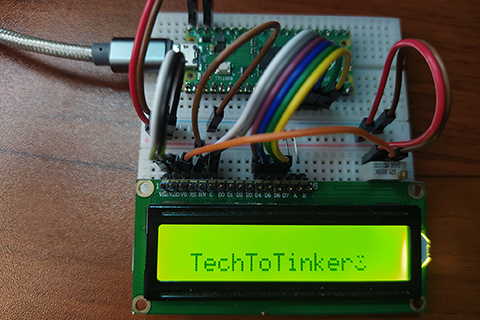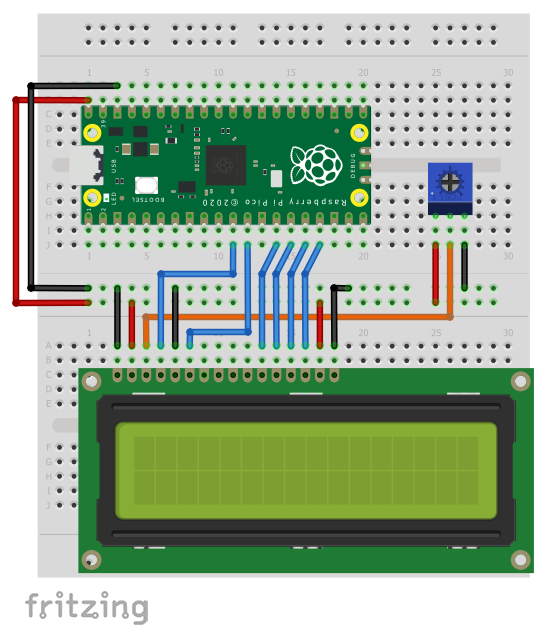002 – Raspberry Pi Pico: LCD 4-bit Mode

In this article, we will learn on how to use the 16×2 LCD module in 4-bit Mode with MicroPython language. For this tutorial, we will used a Raspberry Pi Pico with MicroPython firmware.
BILL OF MATERIALS:
- Raspberry Pi Pico development board.
- 16×2 LCD module the ordinary one without I2C interface.
- Breadboard to hold and connect the circuit.
- Jumper wires to connect the circuit.
CIRCUIT DIAGRAM:

HARDWARE INSTRUCTION:
- Connect the LCD VSS pin to the ground.
- Connect the LCD VDD pin to the 5V pin.
- Connect the LCD VO pin at the center wiper of the potentiometer.
- Connect the LCD RS pin to GPIO 8 of the Pico.
- Connect the LCD RW pin to the ground pin.
- Connect the LCD E pin to the GPIO 9 of the Pico.
- Connect the LCD D4 pin to the GPIO 10 of the Pico.
- Connect the LCD D5 pin to the GPIO 11 of the Pico.
- Connect the LCD D6 pin to the GPIO 12 of the Pico.
- Connect the LCD D7 pin to the GPIO 13 of the Pico.
SOFTWARE INSTRUCTION:
- Copy the lcd_api.py and the gpio_lcd.py to the Raspberry Pi Pico MicroPython root directory.
- Try the sample source code and adapt it according to your needs.
VIDEO DEMONSTRATION:
CALL TO ACTION:
For any concern, write your message in the comment section.
You might also like to support my journey on Youtube by Subscribing. Click this to Subscribe to TechToTinker.
Thank you and have a good days ahead.
See you,
– George Bantique | tech.to.tinker@gmail.com
SOURCE CODE:
1. Example source code for exploring the basic functions:
# More details can be found in TechToTinker.blogspot.com
# George Bantique | tech.to.tinker@gmail.com
from machine import Pin
from gpio_lcd import GpioLcd
# Create the LCD object
lcd = GpioLcd(rs_pin=Pin(8),
enable_pin=Pin(9),
d4_pin=Pin(10),
d5_pin=Pin(11),
d6_pin=Pin(12),
d7_pin=Pin(13),
num_lines=2, num_columns=16)
# #The following line of codes should be tested using the REPL
#
# #1. To print a string to the lcd, you can use
lcd.putstr('Hello world!')
# #2. Now, to clear the display.
# lcd.clear()
# #3. and to exactly position the cursor location
# lcd.move_to(1,1)
# lcd.putstr('TechToTinker')
# # If you do not set the cursor position,
# # the character will be displayed in the
# # default cursor position starting from
# # 0, x and 0, y location which is the top left-hand side.
# # There are other useful functions we can use in using the lcd.
# #4. Show the cursor
# lcd.show_cursor()
# #5. Hide the cursor
# lcd.hide_cursor()
# #6. Turn ON blinking cursor
# lcd.blink_cursor_on()
# #7. Turn OFF blinking cursor
# lcd.blink_cursor_off()
# #8. Disable display
# lcd.display_off()
# this will only hide the characters
# #9. Enable display
# lcd.display_on()
# #10. Turn backlight OFF
# lcd.backlight_off()
# #11. Turn backlight ON
# lcd.backlight_on()
# # 12. Print a single character
# lcd.putchar('x')
# but this will only print 1 character
# #13. Display a custom characters
# happy_face = bytearray([0x00,0x0A,0x00,0x04,0x00,0x11,0x0E,0x00])
# lcd.custom_char(0, happy_face)
# lcd.putchar(chr(0))
2. lcd_api.py :
"""Provides an API for talking to HD44780 compatible character LCDs."""
import time
class LcdApi:
"""Implements the API for talking with HD44780 compatible character LCDs.
This class only knows what commands to send to the LCD, and not how to get
them to the LCD.
It is expected that a derived class will implement the hal_xxx functions.
"""
# The following constant names were lifted from the avrlib lcd.h
# header file, however, I changed the definitions from bit numbers
# to bit masks.
#
# HD44780 LCD controller command set
LCD_CLR = 0x01 # DB0: clear display
LCD_HOME = 0x02 # DB1: return to home position
LCD_ENTRY_MODE = 0x04 # DB2: set entry mode
LCD_ENTRY_INC = 0x02 # --DB1: increment
LCD_ENTRY_SHIFT = 0x01 # --DB0: shift
LCD_ON_CTRL = 0x08 # DB3: turn lcd/cursor on
LCD_ON_DISPLAY = 0x04 # --DB2: turn display on
LCD_ON_CURSOR = 0x02 # --DB1: turn cursor on
LCD_ON_BLINK = 0x01 # --DB0: blinking cursor
LCD_MOVE = 0x10 # DB4: move cursor/display
LCD_MOVE_DISP = 0x08 # --DB3: move display (0-> move cursor)
LCD_MOVE_RIGHT = 0x04 # --DB2: move right (0-> left)
LCD_FUNCTION = 0x20 # DB5: function set
LCD_FUNCTION_8BIT = 0x10 # --DB4: set 8BIT mode (0->4BIT mode)
LCD_FUNCTION_2LINES = 0x08 # --DB3: two lines (0->one line)
LCD_FUNCTION_10DOTS = 0x04 # --DB2: 5x10 font (0->5x7 font)
LCD_FUNCTION_RESET = 0x30 # See "Initializing by Instruction" section
LCD_CGRAM = 0x40 # DB6: set CG RAM address
LCD_DDRAM = 0x80 # DB7: set DD RAM address
LCD_RS_CMD = 0
LCD_RS_DATA = 1
LCD_RW_WRITE = 0
LCD_RW_READ = 1
def __init__(self, num_lines, num_columns):
self.num_lines = num_lines
if self.num_lines > 4:
self.num_lines = 4
self.num_columns = num_columns
if self.num_columns > 40:
self.num_columns = 40
self.cursor_x = 0
self.cursor_y = 0
self.implied_newline = False
self.backlight = True
self.display_off()
self.backlight_on()
self.clear()
self.hal_write_command(self.LCD_ENTRY_MODE | self.LCD_ENTRY_INC)
self.hide_cursor()
self.display_on()
def clear(self):
"""Clears the LCD display and moves the cursor to the top left
corner.
"""
self.hal_write_command(self.LCD_CLR)
self.hal_write_command(self.LCD_HOME)
self.cursor_x = 0
self.cursor_y = 0
def show_cursor(self):
"""Causes the cursor to be made visible."""
self.hal_write_command(self.LCD_ON_CTRL | self.LCD_ON_DISPLAY |
self.LCD_ON_CURSOR)
def hide_cursor(self):
"""Causes the cursor to be hidden."""
self.hal_write_command(self.LCD_ON_CTRL | self.LCD_ON_DISPLAY)
def blink_cursor_on(self):
"""Turns on the cursor, and makes it blink."""
self.hal_write_command(self.LCD_ON_CTRL | self.LCD_ON_DISPLAY |
self.LCD_ON_CURSOR | self.LCD_ON_BLINK)
def blink_cursor_off(self):
"""Turns on the cursor, and makes it no blink (i.e. be solid)."""
self.hal_write_command(self.LCD_ON_CTRL | self.LCD_ON_DISPLAY |
self.LCD_ON_CURSOR)
def display_on(self):
"""Turns on (i.e. unblanks) the LCD."""
self.hal_write_command(self.LCD_ON_CTRL | self.LCD_ON_DISPLAY)
def display_off(self):
"""Turns off (i.e. blanks) the LCD."""
self.hal_write_command(self.LCD_ON_CTRL)
def backlight_on(self):
"""Turns the backlight on.
This isn't really an LCD command, but some modules have backlight
controls, so this allows the hal to pass through the command.
"""
self.backlight = True
self.hal_backlight_on()
def backlight_off(self):
"""Turns the backlight off.
This isn't really an LCD command, but some modules have backlight
controls, so this allows the hal to pass through the command.
"""
self.backlight = False
self.hal_backlight_off()
def move_to(self, cursor_x, cursor_y):
"""Moves the cursor position to the indicated position. The cursor
position is zero based (i.e. cursor_x == 0 indicates first column).
"""
self.cursor_x = cursor_x
self.cursor_y = cursor_y
addr = cursor_x & 0x3f
if cursor_y & 1:
addr += 0x40 # Lines 1 & 3 add 0x40
if cursor_y & 2: # Lines 2 & 3 add number of columns
addr += self.num_columns
self.hal_write_command(self.LCD_DDRAM | addr)
def putchar(self, char):
"""Writes the indicated character to the LCD at the current cursor
position, and advances the cursor by one position.
"""
if char == 'n':
if self.implied_newline:
# self.implied_newline means we advanced due to a wraparound,
# so if we get a newline right after that we ignore it.
pass
else:
self.cursor_x = self.num_columns
else:
self.hal_write_data(ord(char))
self.cursor_x += 1
if self.cursor_x >= self.num_columns:
self.cursor_x = 0
self.cursor_y += 1
self.implied_newline = (char != 'n')
if self.cursor_y >= self.num_lines:
self.cursor_y = 0
self.move_to(self.cursor_x, self.cursor_y)
def putstr(self, string):
"""Write the indicated string to the LCD at the current cursor
position and advances the cursor position appropriately.
"""
for char in string:
self.putchar(char)
def custom_char(self, location, charmap):
"""Write a character to one of the 8 CGRAM locations, available
as chr(0) through chr(7).
"""
location &= 0x7
self.hal_write_command(self.LCD_CGRAM | (location << 3))
self.hal_sleep_us(40)
for i in range(8):
self.hal_write_data(charmap[i])
self.hal_sleep_us(40)
self.move_to(self.cursor_x, self.cursor_y)
def hal_backlight_on(self):
"""Allows the hal layer to turn the backlight on.
If desired, a derived HAL class will implement this function.
"""
pass
def hal_backlight_off(self):
"""Allows the hal layer to turn the backlight off.
If desired, a derived HAL class will implement this function.
"""
pass
def hal_write_command(self, cmd):
"""Write a command to the LCD.
It is expected that a derived HAL class will implement this
function.
"""
raise NotImplementedError
def hal_write_data(self, data):
"""Write data to the LCD.
It is expected that a derived HAL class will implement this
function.
"""
raise NotImplementedError
def hal_sleep_us(self, usecs):
"""Sleep for some time (given in microseconds)."""
time.sleep_us(usecs)
3. gpio_lcd.py :
"""Implements a HD44780 character LCD connected via ESP32 GPIO pins."""
from lcd_api import LcdApi
from machine import Pin
from utime import sleep_ms, sleep_us
class GpioLcd(LcdApi):
"""Implements a HD44780 character LCD connected via ESP32 GPIO pins."""
def __init__(self, rs_pin, enable_pin, d0_pin=None, d1_pin=None,
d2_pin=None, d3_pin=None, d4_pin=None, d5_pin=None,
d6_pin=None, d7_pin=None, rw_pin=None, backlight_pin=None,
num_lines=2, num_columns=16):
"""Constructs the GpioLcd object. All of the arguments must be machine.Pin
objects which describe which pin the given line from the LCD is
connected to.
When used in 4-bit mode, only D4, D5, D6, and D7 are physically
connected to the LCD panel. This function allows you call it like
GpioLcd(rs, enable, D4, D5, D6, D7) and it will interpret that as
if you had actually called:
GpioLcd(rs, enable, d4=D4, d5=D5, d6=D6, d7=D7)
The enable 8-bit mode, you need pass d0 through d7.
The rw pin isn't used by this library, but if you specify it, then
it will be set low.
"""
self.rs_pin = rs_pin
self.enable_pin = enable_pin
self.rw_pin = rw_pin
self.backlight_pin = backlight_pin
self._4bit = True
if d4_pin and d5_pin and d6_pin and d7_pin:
self.d0_pin = d0_pin
self.d1_pin = d1_pin
self.d2_pin = d2_pin
self.d3_pin = d3_pin
self.d4_pin = d4_pin
self.d5_pin = d5_pin
self.d6_pin = d6_pin
self.d7_pin = d7_pin
if self.d0_pin and self.d1_pin and self.d2_pin and self.d3_pin:
self._4bit = False
else:
# This is really 4-bit mode, and the 4 data pins were just
# passed as the first 4 arguments, so we switch things around.
self.d0_pin = None
self.d1_pin = None
self.d2_pin = None
self.d3_pin = None
self.d4_pin = d0_pin
self.d5_pin = d1_pin
self.d6_pin = d2_pin
self.d7_pin = d3_pin
self.rs_pin.init(Pin.OUT)
self.rs_pin.value(0)
if self.rw_pin:
self.rw_pin.init(Pin.OUT)
self.rw_pin.value(0)
self.enable_pin.init(Pin.OUT)
self.enable_pin.value(0)
self.d4_pin.init(Pin.OUT)
self.d5_pin.init(Pin.OUT)
self.d6_pin.init(Pin.OUT)
self.d7_pin.init(Pin.OUT)
self.d4_pin.value(0)
self.d5_pin.value(0)
self.d6_pin.value(0)
self.d7_pin.value(0)
if not self._4bit:
self.d0_pin.init(Pin.OUT)
self.d1_pin.init(Pin.OUT)
self.d2_pin.init(Pin.OUT)
self.d3_pin.init(Pin.OUT)
self.d0_pin.value(0)
self.d1_pin.value(0)
self.d2_pin.value(0)
self.d3_pin.value(0)
if self.backlight_pin is not None:
self.backlight_pin.init(Pin.OUT)
self.backlight_pin.value(0)
# See about splitting this into begin
sleep_ms(20) # Allow LCD time to powerup
# Send reset 3 times
self.hal_write_init_nibble(self.LCD_FUNCTION_RESET)
sleep_ms(5) # need to delay at least 4.1 msec
self.hal_write_init_nibble(self.LCD_FUNCTION_RESET)
sleep_ms(1)
self.hal_write_init_nibble(self.LCD_FUNCTION_RESET)
sleep_ms(1)
cmd = self.LCD_FUNCTION
if not self._4bit:
cmd |= self.LCD_FUNCTION_8BIT
self.hal_write_init_nibble(cmd)
sleep_ms(1)
LcdApi.__init__(self, num_lines, num_columns)
if num_lines > 1:
cmd |= self.LCD_FUNCTION_2LINES
self.hal_write_command(cmd)
def hal_pulse_enable(self):
"""Pulse the enable line high, and then low again."""
self.enable_pin.value(0)
sleep_us(1)
self.enable_pin.value(1)
sleep_us(1) # Enable pulse needs to be > 450 nsec
self.enable_pin.value(0)
sleep_us(100) # Commands need > 37us to settle
def hal_write_init_nibble(self, nibble):
"""Writes an initialization nibble to the LCD.
This particular function is only used during initialization.
"""
self.hal_write_4bits(nibble >> 4)
def hal_backlight_on(self):
"""Allows the hal layer to turn the backlight on."""
if self.backlight_pin:
self.backlight_pin.value(1)
def hal_backlight_off(self):
"""Allows the hal layer to turn the backlight off."""
if self.backlight_pin:
self.backlight_pin.value(0)
def hal_write_command(self, cmd):
"""Writes a command to the LCD.
Data is latched on the falling edge of E.
"""
self.rs_pin.value(0)
self.hal_write_8bits(cmd)
if cmd <= 3:
# The home and clear commands require a worst
# case delay of 4.1 msec
sleep_ms(5)
def hal_write_data(self, data):
"""Write data to the LCD."""
self.rs_pin.value(1)
self.hal_write_8bits(data)
def hal_write_8bits(self, value):
"""Writes 8 bits of data to the LCD."""
if self.rw_pin:
self.rw_pin.value(0)
if self._4bit:
self.hal_write_4bits(value >> 4)
self.hal_write_4bits(value)
else:
self.d3_pin.value(value & 0x08)
self.d2_pin.value(value & 0x04)
self.d1_pin.value(value & 0x02)
self.d0_pin.value(value & 0x01)
self.hal_write_4bits(value >> 4)
def hal_write_4bits(self, nibble):
"""Writes 4 bits of data to the LCD."""
self.d7_pin.value(nibble & 0x08)
self.d6_pin.value(nibble & 0x04)
self.d5_pin.value(nibble & 0x02)
self.d4_pin.value(nibble & 0x01)
self.hal_pulse_enable()
REFERENCES AND CREDITS:
Dave Hylands LCD library: https://github.com/dhylands/python_lcd








Thanks you so much!
I am glad that it helps you. Cheers.